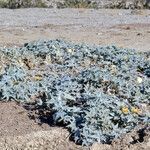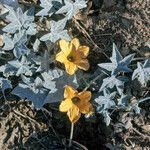Plants perennial; roots tuberous. Stems prostrate, often rooting adventitiously at nodes, to 2 m, villous-hirsute to hispid-hirsute with deflexed hairs, glabrescent and muriculate on angles in age; tendrils mostly 3(–5)-branched 1–1.5 cm above base, retrorsely hispid, gland-tipped. Leaves: petiole (2–)3–7 cm, densely hispid-hirsute with short, deflexed hairs mixed with pustulate hairs; blade suborbiculate to depressed-ovate, palmately 5-lobed, sinuses 1/2–2/3 to petiole, 3–7 × 4–10 cm, usually broader than long or equally so, base cordate, lobes lanceolate-acuminate to triangular or triangular-lanceolate, sometimes irregularly sublobed, margins remotely crenate to remotely serrate-crenate, surfaces appressed-hispid abaxially and muriculate, hirsute-strigillose to hispid-strigose adaxially, midvein and major veins whitish adaxially from densely hispidulous-strigillose with white hairs, eglandular. Peduncles in fruit shallowly 5-ribbed, not abruptly expanded at point of fruit attachment, <3–8 cm>, spongy. Flowers: hypanthium cupulate to campanulate, 2–7(–20) mm; sepals linear-subulate, 2–10 mm; corolla golden yellow to yellow, tubular-campanulate, 2.5–5 cm; anther filaments glabrous; ovary densely pubescent. Pepos dull green, narrowly 10-striped and white-mottled, ellipsoid-globose to globose or depressed-globose, 7–10 cm, smooth. Seeds dull white, ovate to oblong, 9–14 mm, margins thickened-raised, surfaces smooth or slightly rough. 2n = 40.
More
A pumpkin family plant. It is a sprawling vine. The stems and leaves have stiff hairs. The leaves are dark green and have 5 long triangular shaped lobes. The flowers are yellow and 6-8 cm wide. They are stiff and curling. The fruit are round and 8-10 cm across. The fruit are bright yellow and can have white stripes.



